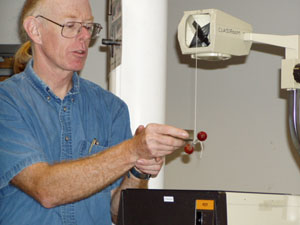Push me a grape

A grape is diamagnetic and is repelled by a
magnet.
Push me a grape

A grape is diamagnetic and is repelled by a
magnet.
Introduction
A grape is repelled by both north and south poles of a strong rare-earth magnet. The grape is repelled because it contains sugar-water which is diamagnetic.
Material
Assembly
Tie the string to the middle of the straw.
Tie or tape the other end of the string to a support structure such
as an overhead projector which will allow the straw to rotate
freely.
Slide two grapes onto the ends of the straw.
( Optional, to make it easier to slide the grapes onto the straws,
make small cuts in the stem ends of two grapes.)
Balance the straw with the grapes on the ends so that it is nearly
level.
To Do and Notice
Bring one pole of the magnet, perhaps a north
pole, near the grape.
Do not touch the grape with the magnet.
The grape will be repelled by the magnet and begin to move slowly away from the magnet.
Remove the magnet and let the grape stop its motion.
Turn the magnet over and bring the other, south, pole near the grape.
The grape will be repelled by the south pole.
Notice that the grape is repelled by both poles of the magnet.
What's Going On?
Iron is ferromagnetic. It is attracted to both poles of a magnet.
Water, which is a main component of grapes, is diamagnetic. Diamagnetic materials are repelled by both poles of a magnet. The diamagnetic repulsion is very weak, a thousand to a million times weaker than ferromagnetism.
There is a third type of magnetic material called paramagnetic. Paramagnetic materials like aluminum are weakly attracted to both poles of a magnet.
Every electron is a magnet because electrons carry
charge and spin.
In addition, an electron in orbit is an electric current, which is an
electromagnet.
Atoms and molecules that have single, unpaired electrons like hydrogen and lithium are paramagnetic. Electrons in these materials orient in a magnetic field so that they will be weakly attracted to magnetic poles. Liquid oxygen is paramagnetic.
In atoms of iron, cobalt and nickel, electrons in one atom will align with electrons in neighboring atoms making regions called domains with very strong magnetization. These materials are ferromagnetic and are strongly attracted to magnetic poles.
Atoms and molecules in which all of the electrons are paired with electrons of opposite spin and in which the orbital currents are zero, such as in helium, water, and bismuth are diamagnetic.
Bring a magnet toward a diamagnetic material, you will induce an electric current in the atoms of that material which make the atoms magnetic in a way that will repel the approaching magnet. (This is the same result as predicted by Lenz's law.)
Going Further
Mount other objects on your torsional pendulum and investigate their magnetic properties.Try aluminum, prunes, wood and more.
Etc
Graphite is also strongly diamagnetic.
Ferromagnetic, diamagnetic, and paramagnetic materials all require quantum mechanics to accurately model their behavior.
There are other types of magnetism such as ferrimagnetism in which electrons in one atom line up with their spins opposite those in neighboring atoms.
References
Details on the diamagnetism of water can be found on page354 of the Electromagnetism book in the Berkeley Physics Series written by Purcell. first edition.
|
Scientific Explorations with Paul Doherty |
|
17 Oct 2002 |